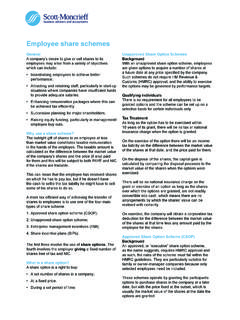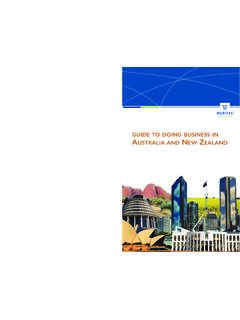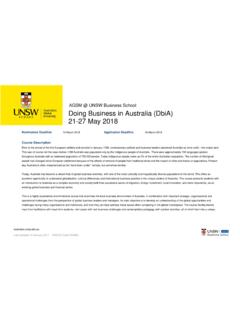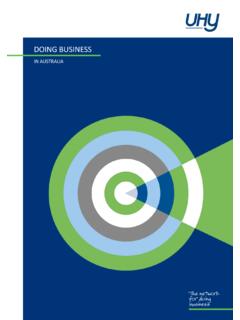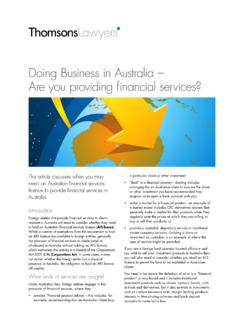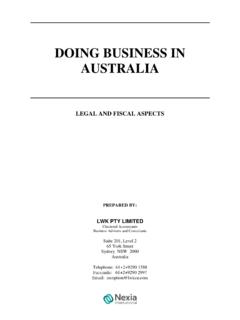Transcription of Doing business in Australia - Scott-Moncrieff
1 About Success Doing business in AustraliaContentsIntroduction 1 Australia at a glance 2 Regulatory environment 4 business structures 6 Taxation 12 How Moore Stephens can help you 24 About us 25 Contact us 26 Our services 271 Doing business in AustraliaIntroductionThe Moore Stephens Doing business in Australia guide aims to provide general information for persons contemplating Doing business and/or individuals intending to live and work in Australia , temporarily or permanently. The guide includes background facts about Australia and relevant information on business operations and taxation matters. This guide is intended to assist organisations that are considering establishing a business in Australia either as a separate entity or as a subsidiary of an existing foreign company. It will also be helpful to anyone planning to come to Australia to work and live there either on secondment or as a permanent life choice.
2 Unless otherwise noted, the information contained in this guide is believed to be accurate as of 1 January 2013. However, general publications of this nature cannot be used and are not intended to be used as a substitute for professional guidance specific to the reader s particular circumstances. Sydney, January 20132 Doing business in AustraliaGeographyAustralia came from the Latin word terra australis incognita meaning the unknown southern continent . It is the world s sixth largest country with land area of 7,692,000 square kilometres but has a population of only approximately million. Australia is one of the largest mineral exporters in the world and is abundant in natural resources such as coal, iron ore, lead, zinc, copper, nickel, bauxite, gold, manganese, tin, silver, uranium, oil and other rare has been estimated that the majority of Australia s population of million are descended from 19th and 20th century immigrants from the United Kingdom.
3 However, more and more people are migrating from countries such as Germany, Greece, Italy, Japan, China, Malaysia, Indonesia, Taiwan, Hong Kong and Vietnam. Today the first Aboriginal Australian accounts for less than one per cent of the total population. Australia , like all developed countries has an ageing population. Australia is the world s sixth largest country with land area of 7,692,000 square kilometres but has a population of only approximately million. Australia is one of the largest mineral exporters in the world and is abundant in natural resources such as coal, iron, lead, zinc, copper, nickel, bauxite, gold, manganese, tin, silver, uranium, oil and other rare metals. SydneyMelbourneHobartCanberraBrisbaneDar winAdelaidePerthWANTSAQLDTASACTNSWVICP opulation by capital city (millions) Population by State/Territory (millions)New South Capital Australia at a glance3 Doing business in AustraliaPolitical environmentThe Australian Federation has a constitutional monarchy system of government as well as a cabinet system.
4 The current British Queen Elizabeth II is the Queen of Australia and is also head of state. The Queen is represented by a Governor-General at a federal level and by Governors at a state level. Although the Australian Constitution provides executive powers to the Governor-General, these are normally exercised only on the advice of the Prime Minister. Australia has six States and two Territories. It also has Local Governments with powers vested by the State and Territory Governments. There are three levels of government in Australia . The Commonwealth Government is responsible for areas such as taxation, defence, foreign affairs, foreign investment, immigration, trade and commerce. The state and territory governments are responsible for indirect taxes, infrastructure, water, education, energy and emergency services. Local governments focus primarily on the usage of land and the assessment / approval of development largest political groups in Australia are the Liberal Party of Australia and the Australian Labour and currencyThe national language spoken in Australia is English.
5 The currency used is dollars and cents. One hundred cents equal one Australian environmentAustralia is a developed country and since the 1990 s, the economy has grown at a rapid pace. Australia has faired better than most other developed countries during the global financial crisis. The economic development is driven by its highly developed mineral resources, tourism and education sectors. The legal and tax systems have a high degree of transparency. A sound financial system, a high degree of economic freedom and market stability are just a few factors that make investing in Australia a great business in AustraliaA number of regulatory bodies oversee various functions in Australia . These include: Australian Securities and Investments Commission (ASIC)The Australian Securities and Investments Commission is the single regulator of Australian registered companies. ASIC administers the Corporations Act, the law regulating incorporation, operation and management of Taxation Office (ATO)The Australian Taxation Office, under the Commissioner of Taxation, is the statutory authority responsible for administering Australia s federal taxation ATO administers the process of annual self-assessment and conducts random audits to verify assessments.
6 The ATO also collects excise on tobacco, petrol and alcohol, administers the Higher Education Contribution Scheme and the Private Health Insurance Rebate, and has responsibility for the fiscal regulation of Australia s superannuation Investment Review Board (FIRB)The Foreign Investment Review Board is a non-statutory organisation formed in 1976 to provide foreign investment policy advice to the Australian Federal Government. The FIRB s function is to assess direct investment proposals submitted by foreign interests and to make recommendations to the Australian Federal Government on the compatibility of those proposals with Government policy and regulation. FIRB also provides information on the Government s policies to prospective foreign investors and potential investors has a very transparent and efficient regularity environmentAll proposals above certain thresholds need prior approval and need to be notified. The following acquisitions must be notified, irrespective of the value or the nationality of the investor: all vacant non-residential land all residential real estate (some exemptions apply) all shares or units in Australian urban land corporations or trust estates, and all direct investments by foreign governments or their agencies, including proposals to establish new business in AustraliaAt Moore Stephens, our services do not just start from the tax audit stage.
7 We realise the importance of being involved with your tax compliance needs before any tax review. All other acquisitions (including shares or assets of an Australian business ) should be notified if the target entity is valued at/above the applicable monetary threshold set by the policy or the US Investors as at 1 January 2013$5 milliondeveloped non residential commercial real estate, where the property is subject to heritage listing$54 milliondeveloped non residential commercial real estate, where the property is not subject to heritage listing$248 million* an interest in an Australian business , or an interest in an offshore company that holds Australian assets or conducts a business in Australia , and the Australian assets or businesses of the target company are valued at/above the thresholdUS Investors as at 1 January 2013$248 million*involving AUSFTA prescribed sensitive sectors: an interest in an Australian business , or an interest in an offshore company that holds Australian assets or conducts a business in Australia , and the Australian assets or businesses of the target company are valued at/above the threshold$1078 million*developed non residential commercial real estate$1078 million*not involving AUSFTA prescribed sensitive sectors: an interest in an Australian business , or an interest in an offshore company that holds Australian assets or conducts a business in Australia , and the Australian assets or businesses of the target company are valued at/above the threshold* The threshold is indexed business in AustraliaA business in Australia may be operated by an individual, a trust, a company, a joint venture, a partnership (including limited partnerships in certain states) or a branch of a foreign company.
8 Each has different legal and taxation Australia , foreign enterprises most commonly conduct business through a company and/or branch business venture has risks but for a business to be profitable, companies have to determine the optimum balance between risks and opportunities. Australian companies are governed by the Corporations Act, their constitution and common are essentially five types of companies: a company limited by shares a company limited by guarantee a company limited by shares and guarantee a company with unlimited liability, and a no liability company (only available to mining companies).All Australian companies are required to disclose their ACN (Australian Company Number) or ARBN (Australian Registered Body Number) on all official documents. Companies controlled by, and foreign branches owned by, foreign enterprises may be required to lodge audited accounts with the three most common corporate structures in Australia are:1.
9 Public company (limited by shares)This company may borrow money from the public and the public may subscribe to and deal in its shares. Typically this type of company is listed on the various stock exchanges in sound financial system, a high degree of economic freedom and market stability, are just a few factors that make investing in Australia a great structures2. Proprietary company (limited by shares)The most predominant type of entity used in Australia is the proprietary type of company is prohibited from borrowing money from the public and cannot allow free trade in its are no residency restrictions on members and no general minimum capital requirements for an Australian proprietary company. A company is managed by the directors of the company, but is owned by its members. 7 Doing business in AustraliaA company is a separate legal entity and is liable for its own obligations. The liability of the members will generally be limited to the unpaid amount on any shares held or a specified Foreign company branchA foreign company may carry on business in Australia as an Australian branch.
10 To carry on business in Australia as a branch, the foreign company must register as a foreign company with registered, the foreign company is required to lodge copies of its financial statements and comply with various notification obligations under the Corporations main differences between these types of companies are in the following areas:1. DisclosureThere are higher levels of disclosure for public companies. Likewise, there are higher levels of disclosure for large proprietary companies compared to small proprietary AuditSmall proprietary companies are not required to have their accounts audited except in limited circumstances. Large proprietary companies and public companies both require their accounts to be Holding of AGMs Proprietary companies are not required to hold an annual general meeting although some, in limited circumstances, may be obliged to hold a general meeting of the company. Public companies must hold an annual general meeting not later than five months after the end of each financial the purposes of accounts presentation all companies must determine whether they are reporting entities or non-reporting entities.


